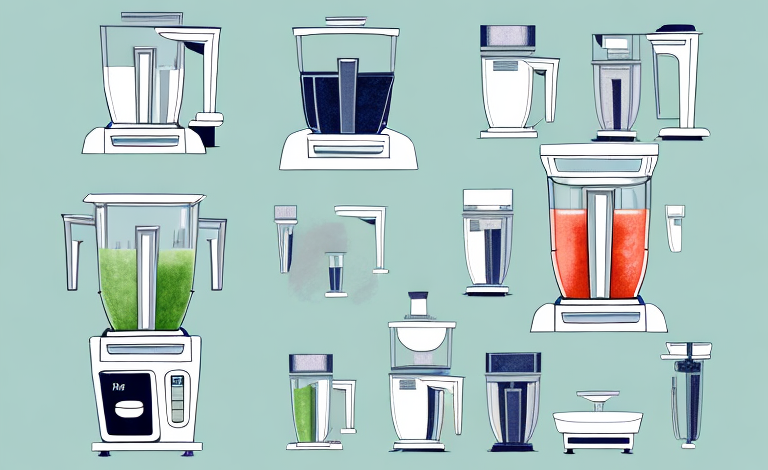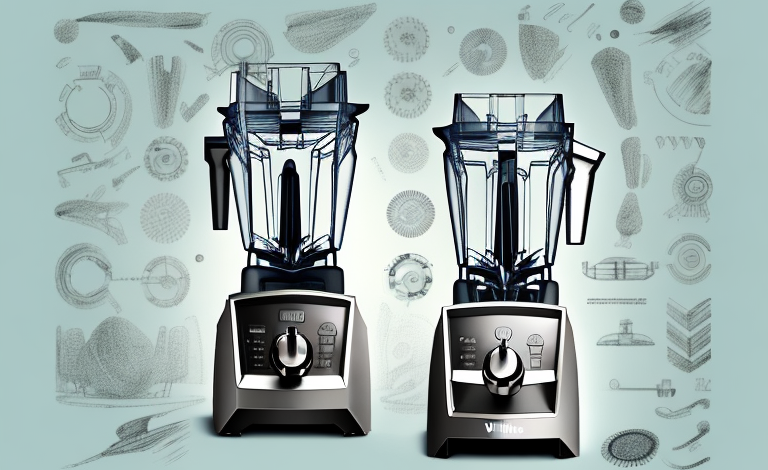If you’re interested in making healthy drinks like juices or smoothies, you may have wondered about the difference between using a juicer versus a Vitamix blender. Both can create delicious, nutritious drinks, but which one is better? In this article, we’ll explore the pros and cons of using a juicer and a Vitamix blender, and answer the question of whether or not you need both appliances in your kitchen.
Understanding the difference between a juicer and a Vitamix blender
The primary difference between a juicer and a Vitamix blender lies in how they process fruits and vegetables. A juicer extracts the liquid from produce and separates it from the fibrous pulp, resulting in a clear, smooth juice. In contrast, a Vitamix blender uses high-powered blending to pulverize the whole fruits and vegetables into a smoothie or puree, which retains all of the fiber from the produce.
While juicing is a great way to consume a large amount of nutrients in a single glass, it can also be quite wasteful. Juicers discard the pulp, which contains a significant amount of fiber and other nutrients. On the other hand, a Vitamix blender retains all of the fiber and nutrients from the produce, making it a more efficient way to consume fruits and vegetables.
Another advantage of using a Vitamix blender is that it allows you to create a wider variety of recipes. With a juicer, you are limited to making juice, whereas a Vitamix blender can be used to make smoothies, soups, sauces, and even nut butters. This versatility makes it a more practical investment for those who want to experiment with different recipes and get the most out of their kitchen appliances.
How does a juicer work?
There are two main types of juicers: centrifugal and masticating. Centrifugal juicers use a fast-spinning blade to finely chop the produce and push it through a strainer, separating the juice from the pulp. Masticating juicers, on the other hand, use a slower crushing and squeezing motion to extract juice without generating as much heat, which can damage nutrients in the produce.
It is important to note that while centrifugal juicers are faster and more convenient, they may not be as efficient at extracting juice from leafy greens and softer fruits. Masticating juicers, on the other hand, are better suited for these types of produce and can also produce a higher yield of juice. However, they tend to be more expensive and require more time and effort to clean. Ultimately, the type of juicer you choose will depend on your personal preferences and juicing needs.
How does a Vitamix blender work?
Vitamix blenders use high-powered blades to blend fruits, vegetables, and other ingredients into a smooth puree or smoothie. The blender’s powerful motor and sharp blades can easily handle tough produce like leafy greens, nuts, and seeds. Unlike juicers, which separate the pulp from the juice, Vitamix blenders blend the whole produce, resulting in drinks that retain all of the fiber from the produce.
Additionally, Vitamix blenders have variable speed settings that allow users to control the texture and consistency of their blends. This feature is particularly useful for creating soups, sauces, and dips, as it allows for precise blending and pureeing. Vitamix blenders also come with tamper tools, which can be used to push down ingredients that may get stuck during blending, ensuring that everything is blended evenly. Overall, Vitamix blenders are a versatile and powerful tool for creating healthy and delicious blends.
Pros and cons of using a juicer
One of the pros of using a juicer is that it can efficiently extract a high yield of juice from produce, resulting in a concentrated nutrient boost. Juicing can also be a great way to consume a lot of produce at once, providing a burst of vitamins and minerals in a small amount of liquid.
However, there are some drawbacks to using a juicer. Because juicers separate the pulp from the juice, you lose out on valuable fiber that’s important for digestion and satiety.
Another potential drawback of using a juicer is that it can be time-consuming and messy to clean. Juicers have many parts that need to be disassembled and washed thoroughly after each use, which can be a hassle for busy individuals.
Additionally, some people may find that drinking large amounts of juice can lead to spikes in blood sugar levels, especially if the juice contains a lot of fruit. It’s important to balance juicing with other healthy eating habits and to consult with a healthcare professional if you have any concerns about your blood sugar levels.
Pros and cons of using a Vitamix blender
Vitamix blenders retain all of the fiber from the produce, making them ideal for people who are interested in getting the maximum nutritional benefits from fruits and vegetables. Vitamix blenders are also versatile and can be used for a variety of other tasks, like making nut butter, grinding grains, or crushing ice.
However, one downside of using a Vitamix blender is that it can be difficult to get an extremely smooth texture if you’re juicing ingredients with a lot of pulp. It can also be time-consuming to clean the blender thoroughly after each use, as it needs to be taken apart and washed carefully to avoid any leftover residue.
What are the benefits of juicing?
Drinking fresh juices made with a juicer can be an excellent way to consume a high volume of produce with minimal effort. Juices can also be a great way to detoxify and energize your body, and they’re often used in juice cleanses or fasts as a way to give the digestive system a break and support overall health.
Another benefit of juicing is that it can help boost your immune system. Many fruits and vegetables contain vitamins and minerals that are essential for a healthy immune system, and juicing allows you to consume these nutrients in a concentrated form. Additionally, some fruits and vegetables, such as ginger and turmeric, have anti-inflammatory properties that can help reduce inflammation in the body and support immune function.
Finally, juicing can be a great way to add variety to your diet. It’s easy to get stuck in a rut with the same fruits and vegetables, but juicing allows you to experiment with different combinations and flavors. You can also add herbs and spices to your juices for added flavor and health benefits. Overall, juicing can be a fun and delicious way to support your health and wellbeing.
What are the benefits of blending with a Vitamix?
Blending with a Vitamix blender can help you create thick, creamy smoothies that are filling and easy to consume on-the-go. Smoothies are also versatile and can be tailored to specific nutritional goals, like adding protein powder for muscle recovery, or adding superfoods like spirulina or chia seeds for an extra nutrient boost.
In addition to creating delicious smoothies, blending with a Vitamix can also help you make homemade nut butters, soups, and sauces. The powerful motor and sharp blades can easily blend tough ingredients like nuts and vegetables, making it a versatile tool in the kitchen. Plus, making your own nut butters and sauces allows you to control the ingredients and avoid added sugars and preservatives found in store-bought versions.
Can you juice with a Vitamix blender?
While you can’t technically juice with a Vitamix blender, you can create a similar effect by blending fruits and vegetables and then straining the mixture through a nut milk bag or cheesecloth. This will allow you to separate the pulp from the liquid, resulting in a smoother texture. However, this process can be time-consuming and messy, so it’s not ideal for regular juicing.
Can you blend with a juicer?
You technically can blend with a juicer, but it’s not recommended. Juicers are designed to extract liquid from produce and don’t have the same high-powered blending capabilities as a Vitamix blender. If you try to blend in a juicer, you’ll likely end up with a chunky, uneven mixture that’s not very drinkable.
Which is more cost-effective: buying a juicer or Vitamix blender?
The cost of a juicer versus a Vitamix blender can vary widely, depending on the brand and model you choose. However, in general, juicers tend to be more affordable than Vitamix blenders. That said, a high-quality juicer can still cost several hundred dollars, so it’s worth considering whether or not you’ll actually use it enough to justify the expense.
Which is more versatile: buying a juicer or Vitamix blender?
Vitamix blenders are generally more versatile than juicers because they can handle a wider variety of tasks beyond just making juice. With a Vitamix blender, you can make smoothies, soups, dips, and more. Juicers, meanwhile, are primarily designed for just one task: extracting juice.
Tips for getting the most out of your juicer
To get the most out of your juicer, it’s important to choose the right produce. Softer fruits like berries and citrus fruits can be difficult to juice, so opt for firm, dense fruits like apples or pears instead. You can also add leafy greens or vegetables to your juices for an extra nutritional boost.
Tips for getting the most out of your Vitamix blender
When using a Vitamix blender, it’s important to start slow and gradually increase the speed as you blend. This will help prevent splatters or spills. It’s also a good idea to add ingredients in small batches to avoid overwhelming the blender’s motor. Finally, be sure to thoroughly clean your blender after each use to prevent mold or bacteria growth.
Comparing the nutrient content in juices vs smoothies made in a Vitamix blender
The nutrient content in juices versus smoothies can vary depending on the types of produce you use, but in general, juices tend to have a higher concentration of vitamins and minerals. This is because juicers extract the liquid from the produce, resulting in a more concentrated nutrient content. However, smoothies made in a Vitamix blender retain all of the fiber from the produce, which can help you feel fuller for longer and aid in digestion.
Recipes for healthy juices and smoothies that can be made in both a juicer and Vitamix blender
There are countless recipes for healthy juices and smoothies that can be made in both a juicer and a Vitamix blender. Here are a few to get you started:
- Green Juice: 2 green apples, 1 bunch kale or spinach, 1 lemon, 1 inch ginger
- Pineapple Ginger Smoothie: 2 cups fresh pineapple chunks, 1 banana, 1 inch ginger, 1 cup coconut water
- Berry Blast Smoothie: 1 cup mixed berries, 1 banana, 1 tablespoon chia seeds, 1 cup almond milk
Conclusion: To juice or to blend? That is the question for your health goals
In the end, the decision of whether or not to invest in a juicer or a Vitamix blender will depend on your personal preferences and health goals. If you’re looking to consume a high volume of produce in a concentrated form, a juicer may be the better choice. However, if you’re interested in maximizing the nutritional benefits of fruits and vegetables and want a more versatile kitchen appliance, a Vitamix blender may be the way to go.



